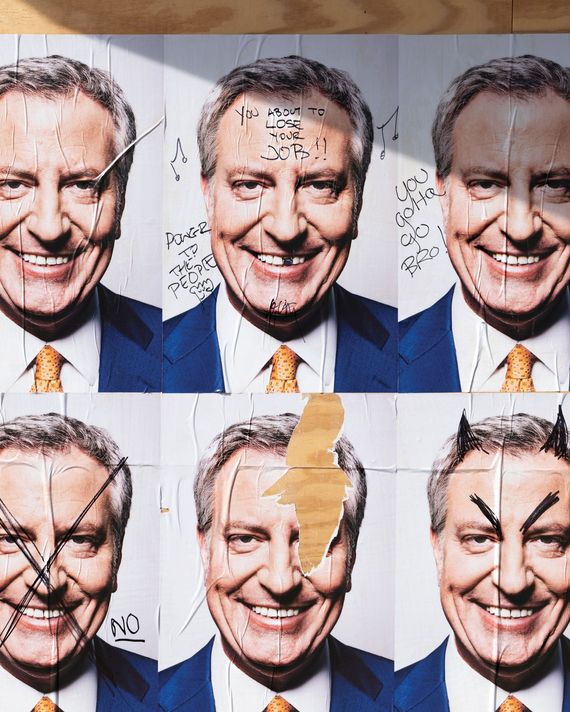
This article was featured in One Great Story, New York’s reading recommendation newsletter. Sign up here to get it nightly.
The protesters lined up, hundreds deep, hoping to rally on the steps of City Hall and raise a ruckus loud enough for the mayor to hear from his corner office. They hoisted signs that read BDB: WHAT HAPPENED TO BEING THE FAIREST CITY? and STOP KILLING BLACK PEOPLE and NO RACIST POLICE. They chanted about how they wanted justice, chanted about when they wanted it and about what they would do if they didn’t get it now: “Shut! It! Down!”
Unlike most of the tens of thousands of protesters who have poured onto city streets over the past several weeks, the members of this group could probably have just told the mayor himself, or at least sent an email. They were his former and current administration employees, people who worked in either City Hall or one of the dozens of municipal agencies that make up city government, and they were boiling mad. This made the protest pretty much unprecedented in the history of New York civil unrest.
It was the second Monday in June, a postcard-perfect afternoon, and after three long months of lockdown, the city was at last scheduled to begin the slow process of reopening. And so the protesters were screaming at an empty building. The mayor was on the other side of the East River, at the Brooklyn Navy Yard, hailing the progress New York had made against COVID-19, announcing new protected bus lanes and an extension of the alternate-side-parking suspension. “It’s a day to celebrate,” he said.
Meanwhile, back at City Hall, Ifeoma Ike, who had been deputy executive director of the city’s Young Men’s Initiative until 2017, was accusing the mayor of presiding over “a racist administration.”
“I am standing here on the backs of so many people that have been pushed out of this administration for raising the reality of what they have to endure when they go home,” she told the crowd. “Do you know how crazy it is to work for this city and then explain to your community why you work for a man who pimps out his family? Because that’s what the fuck it is! You use your family to then have us vote for you. And then you expand the police!
“You may think you are a lame duck, but everybody who is behind us is going to make sure that you are accountable to the promises that you claimed you believed in!” she continued into a bullhorn, while the bureaucrats, government-affairs specialists, and political operatives behind her roared their approval. “You claimed you believed in a ‘Tale of Two Cities.’ But that is not a story about rich and poor; it is a story about the police and the rest of us!”
It was an extraordinary moment, capping off a period unlike any New York has ever undergone, in which a video of a brutal police killing 1,000 miles away ricocheted into a city where nearly a million people had lost their jobs, millions more had been living in home confinement for months, and a video of a white woman falsely accusing a Black man of threatening her in Central Park had racked up 40 million views in 24 hours.
And the mayor, who stormed into office in 2014 promising to make the city more equitable and fair and who was buoyed by dissatisfaction with the liberal status quo, seemed exposed and out of touch. It began even before this recent spate of protests, as the police began enforcing social-distancing guidelines and 90 percent of those arrested were Black or Latino. Social media was awash in images of crowded parks in white neighborhoods of Manhattan, where friendly police officers handed out masks to those who didn’t have them, while a young Black mother was pinned to the ground in a Brooklyn subway station after cops attempted to get her to cover her face and, on the Lower East Side, an officer was videotaped with his knee on the neck of an African-American man for the crime of failing to keep six feet apart.
The mayor denounced the handling of these incidents but initially defended the enforcement of social distancing and bristled at critics who compared it to the police practices of Mayor Michael Bloomberg. “What happened with stop and frisk was a systematic, oppressive, unconstitutional strategy that created a new problem much bigger than anything it purported to solve,” de Blasio said on May 7. “This is the farthest thing from that. This is addressing a pandemic.”
Then the protests got under way. The mayor defended police officers who drove their cars through a crowd of protesters surrounding them, saying, “I’m not going to blame officers who are trying to deal with an absolutely impossible situation.” As mayors around the country marched or took a knee, de Blasio didn’t. During a period when activists surrounded Gracie Mansion for a silent vigil, he mostly stayed inside, favoring virtual press conferences with a socially distant press corps that had long grown tired of him.
And on this day in June, when hundreds gathered downtown, the mood was raw and urgent as workers spoke of their frustration. They called for the mayor to live up to his promises on policing and be the kind of reformer they believed him to be when they joined his government. The group ranged from some who had worked only on his first campaign to others who had spent the past six years working on his behalf. The protest grew so big that senior managers said they felt obligated to go just to show support for their staff.
“We can’t afford for someone to put a video of their Black son on a campaign ad and then talk about how they are going to stop police brutality and reform criminal justice and then just turn around and betray the Black community and betray New Yorkers,” Michael Cox, a former senior policy adviser in the office of the mayor, told me. “At some point, it has to stop.”
“The mayor’s comments have been hurtful and tone-deaf to the cry of the people that voted for him and worked for him,” shouted Jeremiah Cedeño, who works in Census outreach for the city, as hundreds behind him cheered. “We as a city are done!”
The group marched over to One Police Plaza, where members of the NYPD looked on as everyone took a knee, raised a fist and then continued over the Brooklyn Bridge to Cadman Plaza. Bill de Blasio is a mayor who sees himself as a revolutionary. Early in his tenure, he fought with the police unions and tried to reform the NYPD, but he seemed to back off as the unions indicated they would show no mercy in this battle and the department itself proved unmovable. Now there was a real uprising happening in the streets, one that caught City Hall unawares and was coming right to, and out of, its front door.
“My concern is not for my job. My concern is for the future of this city,” said Manvir Singh as he leaned against the Municipal Building across the street from City Hall. Working for the mayor had been his first job out of college, and he was now in intergovernmental affairs, working closely with City Hall. “I didn’t know what change could look like until I worked here, but I also didn’t know what systemic racism could look like until I worked here.”
Catherine Almonte worked as close to the mayor as possible; as his “body person,” she was with him all day. She worked for his campaign and went on to the city’s Census outreach bureau. She had been in small meetings the mayor had with police brass. “The NYPD just creates a fog around the mayor, and they keep him from seeing clearly,” she told me as the march made its way over the bridge. “I’m hoping this is the way to pull him out of that and actually create change.”
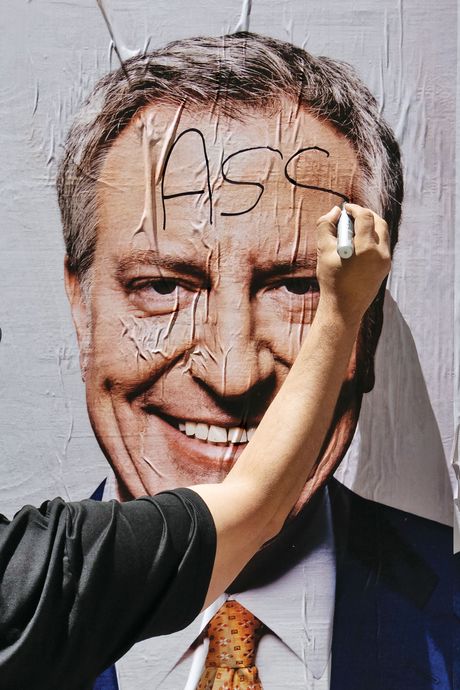
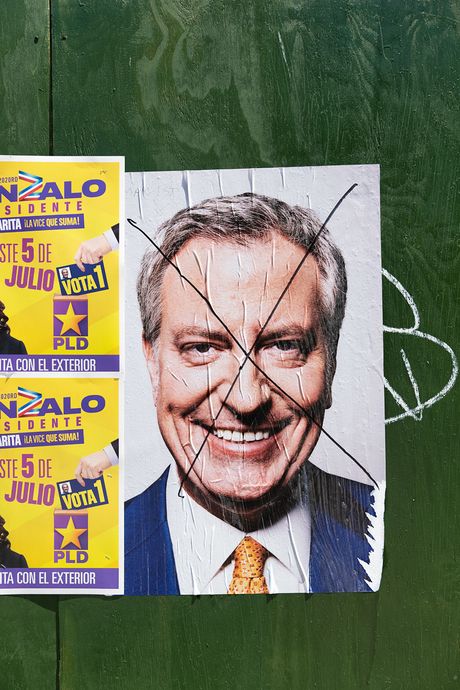
It may be hard to believe, but de Blasio was elected mayor at a time of relative peacefulness, with the city’s crime rates plummeting. The trend continued through his first term, even as the NYPD went to war with him over rhetorical slights and modest efforts at further reform. But, like the cops, he sees the city as still shadowed by the 1980s. He got his start working for the David Dinkins campaign in 1989. He then went to work for the Dinkins administration in City Hall, where he met Chirlane McCray, the future first lady.
Twice during de Blasio’s four years under Dinkins, the city erupted. The first time, in Crown Heights, a neighborhood seething with racial tensions, a car in the motorcade carrying the leader the leader of the Orthodox Jewish Chabad movement struck two Guyanese-American children playing on the sidewalk. As one of the kids lay pinned underneath a car, police and private Orthodox EMTs whisked the driver safely away. Ethnic battles broke out on the streets. A crowd of Black youths surrounded Yankel Rosenbaum, a Hasidic doctoral student, and stabbed him to death. The neighborhood shook for three days. The press reported that the police were told to stand down, and they later retreated in the face of overwhelming numbers of rioters. There were reports of cries like “Hitler didn’t finish the job,” and Jewish residents said what was happening was a pogrom.
Former colleagues recall de Blasio, the kid from Boston who went to NYU and then volunteered in Nicaragua, walking through the neighborhood afterward in shock. “He is carrying that lesson into this moment,” says one. “He is looking at what was happening over these last few weeks and saying, ‘I’m going to have my own Yankel Rosenbaum. That is going to be the story of my mayoralty. There is going to be another pogrom.’ Then, they didn’t let the police strike back, and now, he figures he has to trust his own cops.”
The second eruption happened little more than a year later. This time, the police themselves revolted. Ten thousand of them swarmed downtown Manhattan to protest what they saw as unfair treatment by Dinkins and his call for civilian oversight of the police. Cops knocked over police barricades and stormed the steps of City Hall, spilling onto the Brooklyn Bridge. Led by the soon-to-be Republican mayoral nominee Rudy Giuliani, they held signs that read DUMP THE WASHROOM ATTENDANT and MAYOR, HAVE YOU HUGGED YOUR DEALER TODAY? A pair of police officers stopped Una Clarke, the first Caribbean-born woman elected to the City Council, and one, cupping a beer in his hand, said to the other, “This n- - - - - says she’s a member of the City Council.”
“Bill was completely freaked out by it,” recalls his former colleague. “He saw police officers as blue-collar, working-class folks, people who should be in solidarity with us. The rest of us kind of shrugged and were like, ‘It’s just a bunch of racist fucking cops,’ but it totally spooked him.”
“It was something he used to talk about all the time, just the feeling of powerlessness of it,” says another. “He learned the lesson and used to say that it was not going to happen to him.”
When de Blasio ran for mayor in 2013, he was a criminal-justice reformer, but his approach fell squarely in the middle of the overall Democratic push toward undoing some of the harshest measures of the 1990s. He took his then-teenage son, Dante, everywhere with him, his bouffant Afro proof that, as de Blasio told an associate at the time, “I am running as a Black candidate, and I am going to govern as a Black mayor.”
After he won the primary, his Republican opponent showed footage of a biker gang’s attack on the West Side Highway, interspersed with riots, robberies, subway graffiti, even bodies lying on the sidewalk from the city’s grim past, and ominously warned, “We are one bad mayor from unsafe streets, failing schools, and fiscal chaos.” De Blasio won in a landslide. If his “Tale of Two Cities” campaign theme turned off the city’s elites, he swept the emerging majorities, winning among communities of color and the city’s young white liberals. Once he was in office, the latter group deserted him, and his poll numbers have since remained in the 40 to 50 percent range, even as he won reelection against mostly token opposition.
Early on, former aides say, de Blasio calculated that all the other progressive stuff he wanted to do — from raising taxes on the wealthy, to instituting universal prekindergarten and after-school programs, to closing the yawning gap between rich and poor — would be impossible without keeping crime down. So he rehired William Bratton, who had previously instituted his hard-line “broken windows” policing strategy as Giuliani’s police commissioner, and showered the cops with whatever they asked for: more police, iPhones for every officer, computer tablets, gear.
As issues of race and policing grew central to the Democratic Party, especially during the rise of Donald Trump, de Blasio found himself in the uncomfortable position of urging reformers to go slow. He initially resisted calls to close Rikers Island and opposed increased police-transparency measures put forward by the City Council. But he also instituted the community policing he had campaigned on and called for the cops to stop arresting people for possessing small amounts of marijuana. The city saw over 180,000 fewer arrests, and the jail population recently dropped to its lowest level since 1946, so de Blasio touted the overall decrease in crime and seemed content to let the police force function mostly on its own.
Then Eric Garner was killed. The 43-year-old died after being put in a chokehold by police on a Staten Island street. “This is profoundly personal for me,” the mayor said after a grand jury decided not to indict the officer who had strangled Garner. De Blasio spoke of raising his own son, calling Dante a “good young man, law-abiding young man, who never would think to do anything wrong. Yet because of a history still that hangs over us, the dangers he may face, we’ve had to literally train him, as families have all over this city for decades, in how to take special care in any encounter he has with the police officers who are there to protect him.”
De Blasio’s comments infuriated the police unions, who went to war. Cops turned their backs on the mayor at funerals of slain officers. Patrolmen’s Benevolent Association head Pat Lynch told an interviewer that the cops had been “thrown under the bus” by the mayor (the group was renamed the Police Benevolent Association last year). “We have to teach our children, our sons and our daughters, no matter what they look like, to respect New York City police officers, teach them to comply with New York City police officers,” Lynch said, while Sergeants Benevolent Association head Ed Mullins called de Blasio’s comments “moronic.”
Mullins continued, “If this individual who’s in charge of running this city doesn’t have faith in his own son being protected by the NYPD, he may want to think about moving out of New York City completely. He just doesn’t belong here.”
The criticism and the back-turning shocked the mayor, former aides recall. The following week was the one time when de Blasio didn’t yell at any of his staff, when he seemed subdued and quiet and lingered in his city-issued SUV a beat or two longer to sit by himself before stops. (A de Blasio spokesperson disputes this account.) Police had largely ceased working, engaging in a slowdown that saw traffic tickets and summonses for minor offenses drop 94 percent. It was an audacious move, the cops now turning their backs on de Blasio and on the city they were sworn to protect, and for a moment, his entire mayoralty was at risk.
“He tried to respond in this human, fatherly way,” recalls a former aide, “and they just battered him for it. I don’t think I had ever seen him so rattled.”
Most de Blasio advisers view Lynch and Mullins as men from another era. “Two steps behind the old Confederacy,” as Peter Ragone, a former senior mayoral adviser, puts it. De Blasio’s team reached out to other city and state officials, looking for backup or at least a public statement of condemnation for the unions’ having politicized the slain officers’ funerals, but no one else in the city’s political class was willing to help. De Blasio seemed to let it lie still instead and quietly negotiated generous new contracts for the police unions in the following years.
The dispute got mixed up in the mayor’s ongoing feud with Governor Andrew Cuomo, who this month rebuked de Blasio for voicing support for the police and mused aloud about his constitutional prerogative to remove the mayor from office. Back in 2014, however, Cuomo refused to criticize Lynch for essentially calling the mayor a murderer and hailed the police, accepting a “Man of the Year” award from the PBA the following fall.
“You saved the city,” Cuomo told 200 uniformed officers that day. “The economic success of the city is predicated on what you’ve done and where you’ve brought the city. You did it by remembering the simple, irrefutable rule, which is the law is the law.”
The unions largely stayed out of the mayor’s reelection campaign, as de Blasio positioned himself as an ally of the police and touted the city’s falling crime numbers. But the détente was short-lived. The unions badgered the mayor for his gym habits, greeting him upon arrival at the Park Slope Y after his 11-mile drive from Gracie Mansion, and they bird-dogged his brief presidential bid, not only chanting “Liar!” outside his Good Morning America stop but also having police retirees protest him on the campaign trail, a living reminder to voters that all was not well back home.
“We are out on a mission given to us by someone else,” says a police source. “And there is a feeling that, if we try to carry out the mission, that we are not going to be supported. The mayor asks us to enforce social distancing. Well, when the inevitable backlash comes, what is going to happen to the officer on the street? We could care less about all the new toys. Tell us you have our backs. We work for you.”
If the police can seem like a city agency unaccountable to anyone, to the officers, de Blasio is a mayor unaccountable to his own police department. This stance surprises not just de Blasio but Bratton.
“He treated the department very generously and fought the City Council to secure us extra funds,” says Bratton, who now works for a security consulting firm. He describes the situation early in the mayor’s first term, when the City Council proposed increasing the department’s head count by a thousand. The mayor said no, did a review of what was needed, and ended up adding 300 new officers on top of what the council had proposed.
“He has taken on his own base to support the police,” Bratton says. “He supported a very limited stop-and-frisk policy but didn’t do away with it. He supported the concept of quality-of-life enforcement. As far as I am concerned, he gets a bum rap, both from the police and from the people who supported him in office.”
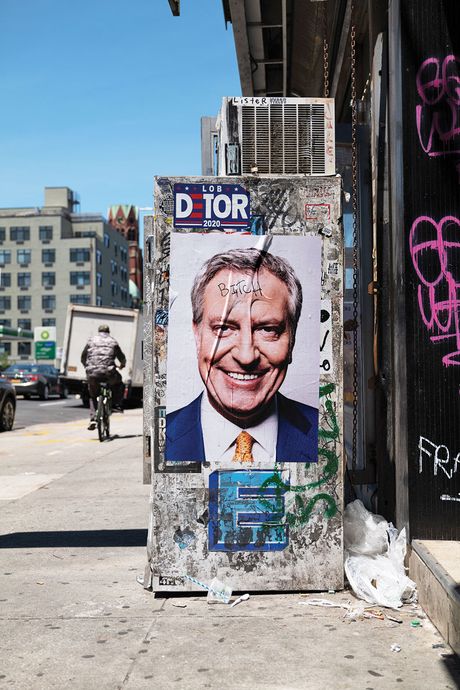
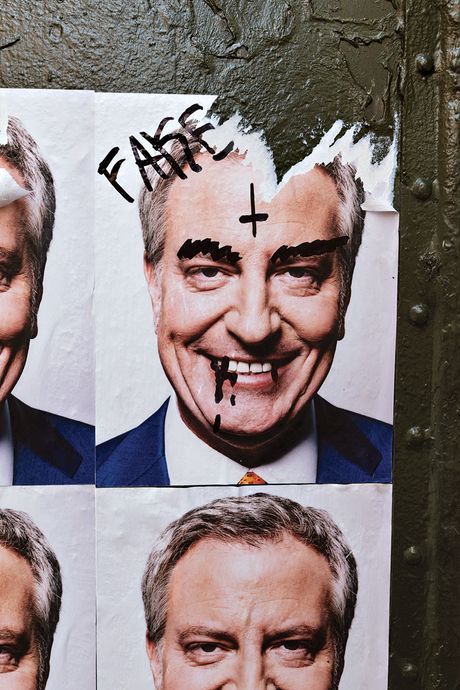
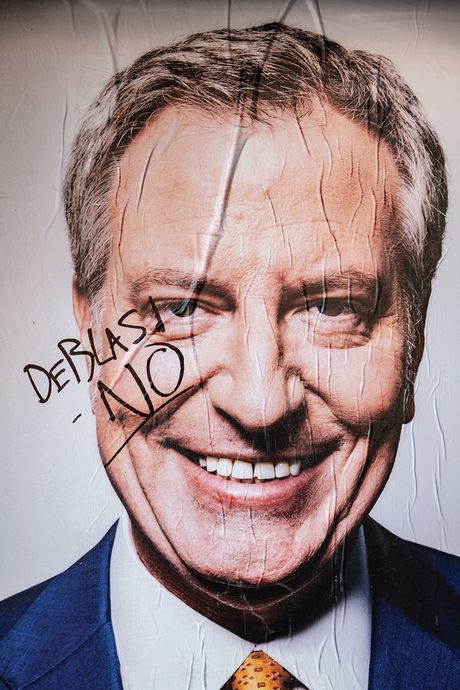
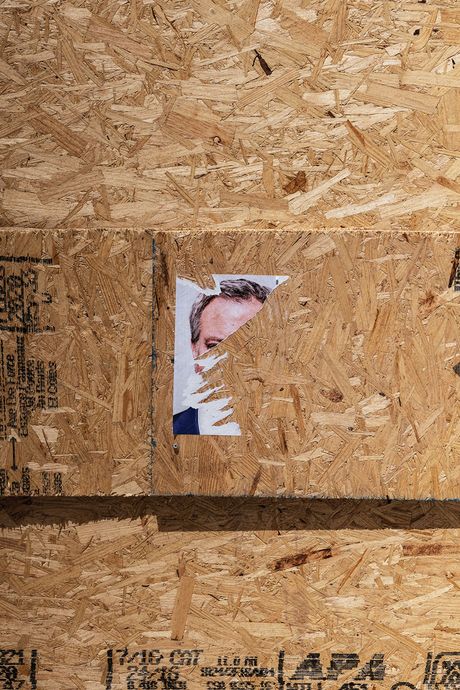
De Blasio isn’t the first New York City mayor to tangle with the police and their unions. It comes with the job. In the 1960s, Mayor John Lindsay presided over riots in Harlem and an NYPD sickout and tried to impose civilian oversight on the police, while the PBA head at the time, Edward J. Kiernan, told reporters, “It’s open season on cops in this city. I refuse to stand by and permit my men to be gunned down while the Lindsay administration does nothing to protect them.” When Mayor Abe Beame was forced to lay off police officers as part of the effort to stave off municipal bankruptcy, police unions fought back by distributing leaflets titled Welcome to Fear City to tourists and warning them not to go out after dark or ride the subway. After Beame, mayors Ed Koch, Rudy Giuliani, and Mike Bloomberg decided it was better to play nice with the unions than to risk war, and even as they held the line on generous raises, they rhetorically stood shoulder to shoulder with the men and women in uniform.
But none of de Blasio’s predecessors dealt with anything like 2020, which has brought one crisis after another — a plague out of the Middle Ages, an economic collapse reminiscent of the Great Depression, a city on the precipice of a long-term fiscal crisis like it’s the 1970s, and now protests over policing like something out of the 1960s.
These are strange days at City Hall. The place has been almost empty thanks to the coronavirus, with many of the mayor’s staffers working from home. The Room 9 press corps and the City Council are deserted. Friends and aides say the mayor is exhausted.
The core group of staffers who were with him as he rose through the City Council to public advocate and who powered his mayoral campaign have largely abandoned him, and many of them have taken to sniping at their former boss on Twitter. The mayor is seldom out among everyday New Yorkers. He kept up his routine at the Park Slope Y in the face of widespread mockery all these years because he said it connected him to his previous, pre-mayoral self, but while there, he rarely talked with his fellow gymgoers. Eagle-eyed Brooklynites have snapped pictures of the mayor walking in Prospect Park, catching him and McCray huddled against each other and glowering at anyone who bothers to interrupt their tête-à-tête.
Part of the problem, longtime friends and aides say, is that de Blasio is one of the few people in New York not really on social media. Until a few years ago, he still used a flip phone. The images that bounce around the internet don’t always reach the mayor, especially now that he’s not surrounded by his usual coterie of aides. Even as some of his own staffers, there to observe the demonstrations, were kettled in with protesters and unable to escape, de Blasio defended the NYPD and the strategy.
“He doesn’t see the footage you and I are seeing on Twitter. He doesn’t see the cops pepper-spraying protesters in the face or running over people,” says one former adviser. “He is counting on the PD or some staffer to tell him what is going on, and he doesn’t get that the world is watching this play out on their phones as it is happening.”
And part of it is that he just doesn’t seem to care. After winning reelection in 2017 despite a daily swirl of negative stories on alleged corruption around his administration, de Blasio grew convinced, aides say, that whatever the media and the elite are obsessed with doesn’t matter much to most New Yorkers. “He doesn’t think he gets credit for the reforms that he pushed through,” says a former adviser. “That is hard for him to accept, and it makes him really angry.”
He dismisses his former advisers who criticize him as people who “live in the world of public relations. I don’t live in that world.” That attitude, though, has long since curdled into an almost sneering contempt for a broad swath of New Yorkers who he thinks hold him in equal disdain.
“I think the big mistake on his part was that he never sought to go north of 59th Street, figuratively speaking at least,” says Bratton. “This is a city that celebrates its culture so much — that’s what brings outsiders here — and ignoring that is his fatal mistake. They accuse Trump of just reaching out to the 40 percent that makes up his base and nobody else, and the mayor makes the same mistake. He has a lot of credibility with the minority community, but he doesn’t engage much or seek the support of the power brokers of the city, and I think that is a mistake.”
Advisers say that being a parent has made this moment harder. His kids were highlighted often in his early political campaigns, and his son worked on his ill-fated presidential run, but they have mostly been absent recently. His 25-year-old daughter, Chiara, who had been quarantining at Gracie Mansion, got arrested during the protests, then had her name tweeted out by one of the police unions. De Blasio seethed privately and to the press, accusing the police of willfully violating her privacy. It showed that the unions saw nothing as off limits when it came to the mayor or his family.
On Friday, May 29, four days after George Floyd’s death, de Blasio was supposed to hold a regularly scheduled meeting with his top security officials to go over the plan for the summer. This year would be different, of course, because kids wouldn’t be in school buildings and New Yorkers would just be emerging from lockdown. The night before, they had heard about a few protests over the Floyd video, which was just starting to make the rounds, but they knew who was leading them. During the Friday meeting, reworked to be about the protests, the mayor’s office sent staff over to observe a nearby rally; they reported that it was peaceful. That night, the animated, sometimes chaotic protests spread to every corner of the city, with police striking back.
On May 31, the mayor went to Bedford-Stuyvesant. His team posted photos on social media of de Blasio meeting with elected officials and locals. When asked why the mayor had come, one of those elected officials, City Councilmember Robert Cornegy, told me, “Because I insisted.”
Cornegy added, “I wanted him to come out because I wanted him to hear from a community perspective of how the police were behaving. We have been peaceful out here, but when the police are heavy-handed, it ends up inciting people more than anything else.” (A spokesperson for the mayor disputes this characterization and says de Blasio called Cornegy “because his district had been the site of some more tense encounters.”)
Cornegy thought the mayor got it, but he was shocked a few hours later when de Blasio announced the first curfew in the city since 1945. “It seems like they are just trying to poke the bear,” Cornegy said, and indeed anyone following along on social media saw peaceful protesters face a police department given license to run roughshod over them.
On Monday, June 1, President Trump, in a conference call with the nation’s governors, told them they needed to “dominate” the unrest in their cities. Governor Cuomo had already sent state troopers to Buffalo, Syracuse, and Rochester and put the National Guard on standby. He called de Blasio and said he was very concerned that what was happening in the city wasn’t enough, that he had to double the police presence to maintain order. Cuomo said, according to one de Blasio aide, “Trump is going to send the Army to New York City.” He said the National Guard was available if the city needed it. (A spokesperson for Cuomo says the governor did not invoke Trump on the call.)
The mayor and Police Commissioner Dermot Shea decided they needed to do something to keep Trump and the governor at bay, so they agreed with Cuomo to institute an 11 p.m. curfew and to double the on-the-ground police force. As de Blasio’s and Cuomo’s teams were working on a joint statement, the governor went on an upstate radio station and announced the curfew for New York City, blowing up the communications plan, according to de Blasio’s office. (“We worked with the city on every part of this announcement,” says a Cuomo spokesperson.) As aides scrambled, they watched on CNN as Trump gave a press conference and then the U.S. Park Police cleared out Lafayette Square Park in D.C. with tear gas.
Back in New York, there were tens of thousands of peaceful marchers but also looting down Fifth Avenue; a policeman was run over by a car in a hit-and-run. So City Hall clamped down further, moving the curfew to eight. The mayor went up to Fordham Road in the Bronx, where some of the worst looting had occurred. Aides say he couldn’t believe what he saw: Here were mom-and-pop businesses that had been in the community for generations, gutted. He heard of children from the neighborhood helping to clear the wreckage — not part of any organization, just there to help.
These were the mayor’s people, as he saw it: the city’s Black working class and small-time entrepreneurs, who’d had their livelihoods devastated first by a pandemic and then by a riot.
If the mayor’s responses during this time were all over the place, it is because the mayor was too. He thought he was a movement guy, part of civil-rights and police-reform crusades. He also believed that the protesters had been mixed in with a bunch of outside agitators determined to cause damage, as well as the stories of small-business owners left to sweep up the glass. A mayor from another era might have figured New Yorkers would be aghast to see police vehicles ablaze, as 13 of them were, by the NYPD’s count, on the first few nights of the protests. But in 2020, a mayor might have figured that, in fact, New Yorkers were aghast to see peaceful marchers being kettled on the side of the road by NYPD officers in riot gear and pepper-sprayed in their faces as the public advocate turned mayor implemented a curfew and effectively shuttered Manhattan to outsiders.
Yet some in the de Blasio administration still see New York City as a success story. The Army stayed away, and so did the National Guard. There was no tear gas, no use of paramilitary police weapons, no deaths on either side, and limited injuries. Other mayors gave beautiful speeches or took a knee with protesters, but their cities burned.
“Did the mayor have some missteps? Yes,” says one aide. “And people that hate him are going to be fixated on it. But all this stuff about the PBA or about the Dinkins administration is bullshit. He wanted to keep New Yorkers safe. Let people take their shots at him if it makes them feel better. It has been like that the entire time he has been here. But this city is going to come out of this okay, and you can’t say that about a lot of cities.”
Although those protesters on the bridge — the ones whose paychecks the mayor signs and who, even if they left their jobs, might seek him out as a reference — were ostensibly there to protest the NYPD, they were also very much there to protest the way the mayor runs his office. Many described a workplace hostile to dissident voices, especially ones coming from Black and Latino staffers.
“Discrimination in his administration had been the dominant mode since the fucking thing started,” says Cristina Gonzalez, who worked in the Mayor’s Office of Appointments until 2017. “It’s in hiring, it’s how people are paid, it’s in microaggressions, it’s everything.” (According to a de Blasio spokesperson, 53 percent of top administration officials are white, down from 79 percent under Bloomberg.)
Many described a workplace where white people were promoted faster and their ideas listened to more. According to Gonzalez, a higher-up in the administration told his staff that straightened hair on women was more professional than natural hair.
“We have bitten our lips one too many times,” said Catherine Almonte, shouting into a bullhorn that had a STAND WITH BLACK WOMEN sticker affixed to its side.
What the public sees in the mayor’s policing is what these protesters say happens behind the scenes. Why in six years has de Blasio had three Irish-American police chiefs, passing over Black deputies? Why the harsh curfew and crackdown if he could see the reality of Black lives?
“I feel like I am working in the Giuliani administration,” says one longtime staffer. “He doesn’t listen to a lot of people. There are a lot of different types of mayors: Bloomberg let his agency heads decide everything; this one has decided that he knows best, he knows more than everybody else, and we are going to do what he says.”
Even de Blasio’s supporters and friends say this quality was evident when the coronavirus first struck, when the mayor was slow to move and ignored the advice of his own Health Department until mass resignations were threatened. Or you could trace it back earlier, to when, against the advice of all counsel, the mayor decided to run for president, a disastrous display that saw him stall at one percent in the polls.
“The problem he has,” says a former adviser, “is that nobody trusts his judgment anymore — not in City Hall, not in the city. And I don’t know how you get that trust back.” In his remaining time in office, the mayor seems determined to get in front of the tumult. He met with civil-rights activists at Gracie Mansion and, at their suggestion, agreed to have a Black Lives Matter mural painted on one street of every borough. He held a conference call with staff in which he told them that he’d heard their concerns, that he was determined to do better, and that their cause was his.
“I have never heard him so contrite,” says one person who was on the call. Much of the mayor’s political focus appears to be on getting McCray elected as Brooklyn borough president next year. She is in charge of the coronavirus racial-equity task force and has been appearing at his side as the administration has attempted to quell the unrest. De Blasio is a political junkie, and keeping one hand in elective office is oxygen. But the calculus of that race has changed dramatically as his reputation sinks.
His response may be to at last go on the offensive with the police unions. When they released his daughter’s arrest information, he called it “unconscionable.” When police unions falsely accused Shake Shack employees of poisoning NYPD officers’ milkshakes, he blasted the union leadership, which “has engaged in racist activities so many times, I can’t even count. I’ve been fighting with these unions from day one,” he said. “These police-union leaders, not all of them, but too many of them, stand in the way of progress.”
His circle of advisers has shrunk to McCray and a few others, such as Ragone and longtime chief of staff Emma Wolfe. The phone calls with allies have begun to taper off. The City Council looks set to drive the agenda on police reform, calling for $1 billion in cuts to the NYPD budget, which will be hard for the mayor to turn down. The election to replace de Blasio is about to begin in earnest, and it appears to be a contest of who can criticize the mayor the most. He faces a growing rebellion at City Hall, upheaval in the streets, a pandemic, and police unions that are more irate than ever. He has lost the confidence of his own staff, his own law enforcement, and by all accounts his own city, and he still has 18 months to go.
*This article has been updated to clarify the events that precipitated the Crown Heights riot.
*This article appears in the June 22, 2020, issue of New York Magazine. Subscribe Now!
































